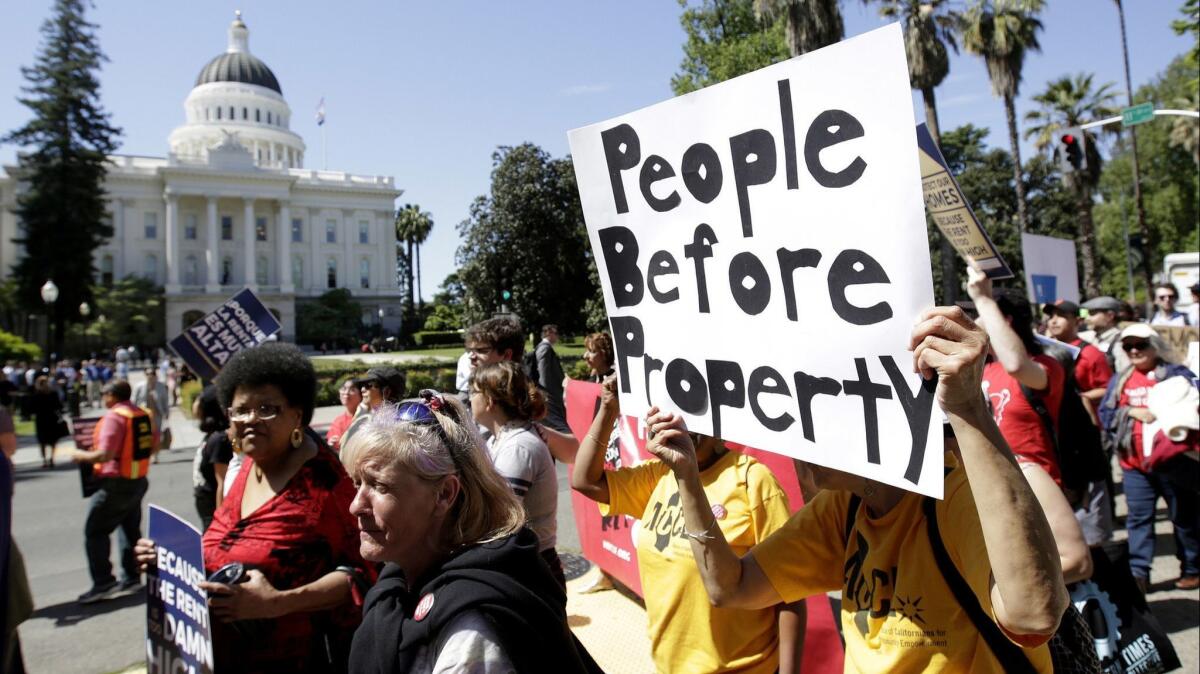Endorsement: Yes on Prop. 21. California has a housing crisis and cities should be able to protect tenants

Proposition 21 may feel like deja vu. Didn’t voters just reject a rent control ballot initiative in 2018? Indeed, they did. But that didn’t stop the AIDS Healthcare Foundation from trying again to convince voters to give cities the freedom to enact or expand rent control — and it shouldn’t deter voters from saying “yes” to Proposition 21.
Here’s why: Rent control can be a helpful tool for cities struggling with gentrification, displacement and homelessness in a booming real estate market. But a state law, the Costa-Hawkins Rental Housing Act of 1995, restricts cities’ ability to enact or expand rent control programs to address their local conditions.
Cities are on the front lines of managing the upheaval and suffering caused by the state’s housing crisis, and now the COVID-19 pandemic. They need the flexibility to adopt policies in response, such as limits on rent increases or temporary rent freezes.
Proposition 21 would help. The initiative would amend Costa-Hawkins and allow — but not require — cities to adopt new renter protections.
Costa-Hawkins bars cities from applying rent control on apartments built after 1995, or earlier in cities that already had rent control in place. (Los Angeles, for example, currently cannot regulate rents in apartments built after 1978.) Proposition 21 would let cities impose rent control on buildings older than 15 years. Why 15 years? That would slowly increase the number of regulated units and ensure developers recoup their investment and have an incentive to build much-needed housing.
Costa-Hawkins forbids rent control on single-family homes and condominiums. Proposition 21 would allow cities to impose rent control on single-family houses or condos — if an individual owns more than two homes. That’s a reasonable response to the growing number of investment companies that have bought up single-family houses and become large-scale landlords.
Costa-Hawkins prohibits “vacancy control,” or keeping rent caps even after the tenant moves out. Under existing law, the landlord can reset the rent to market rate when there is a new tenant. Proposition 21 would allow cities to enact vacancy control in rent-controlled properties, but a landlord would have to be able to increase rents by up to 15% during the first three years after a new tenant moved in. We would discourage cities from enacting vacancy control, which permanently caps landlords’ profits.
Rent control is a balancing act. Research has shown that moderate rent stabilization laws can encourage residential stability and mixed-income communities and limit gentrification and displacement without discouraging new residential construction. More than a dozen cities in California have enacted rent control laws, and there’s little indication those moderate policies have been a significant drag on housing production. Los Angeles, which has rent control, has built more housing in the last few years than in nearly three decades. However, onerous rent controls could discourage investment in rental housing.
Landlord groups argue Proposition 21 isn’t necessary. Last year, Gov. Gavin Newsom signed California’s first statewide rent control law — Assembly Bill 1482 — which limits annual rent increases to 5% plus inflation (which worked out to about 7% in L.A. County for the first half of this year; the figure was lowered to 5.7% in August) and ensures tenants can’t be evicted without cause. But those protections guard only against the most egregious rent hikes and they expire in 2030.
Ultimately, the solution to California’s housing crisis is to build more housing, especially affordable housing. That will take reforming zoning codes and regulations that make it impossible to build apartments and townhomes in many communities across the state. It will require reducing onerous fees and bureaucratic hurdles that layer on costs and push up the price of new homes. This is vital work to make California more affordable, but it will take years to construct enough homes to bring down prices. Until then, rent control can be a helpful tool to provide housing stability.
More to Read
Updates
2:04 p.m. Sept. 16, 2020: This editorial was updated to reflect that the allowable rent increase in L.A. County dropped to 5.7% in August.
A cure for the common opinion
Get thought-provoking perspectives with our weekly newsletter.
You may occasionally receive promotional content from the Los Angeles Times.










